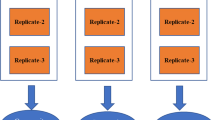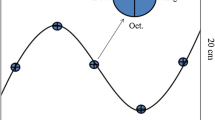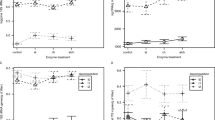Abstract
Changes in the fungal and bacterial biomass and community structure in litter after the volcanic eruptions of Mount Usu, northern Japan were investigated using a chronosequence approach, which is widely used for analyzing vegetation succession. The vegetation changed from bare ground (10 years after the eruptions) with little plant cover and poor soil to monotonic grassland dominated by Polygonum sachalinense with undeveloped soil (33 years) and then to deciduous broad-leaved forest dominated by Populus maximowiczii with diverse species composition and well-developed soil (100 years). At three chronosequential sites, we evaluated the compositions of phospholipid fatty acids (PLFAs), carbon (C) and nitrogen (N) contents and the isotope ratios of C (δ13C) and N (δ15N) in the litter of two dominant species, Polygonum sachalinense and Populus maximowiczii. The C/N ratio, d13C and d15N in the litter of these two species were higher in the forest than that in the bare ground and grassland. The PLFAs gradually increased from the bare ground to the forest, showing that microbial biomass increased with the development of the soil and/or vegetation. The fungi-to-bacteria ratio of PLFA was constant at 5.3 ± 1.4 in all three sites, suggesting that fungi were predominant. A canonical correspondence analysis suggested that the PLFA composition was related to the successional ages and the developing soil properties (P < 0.05, ANOSIM). The chrono-sequential analysis effectively detected the successional changes in both microbial and plant communities.
Similar content being viewed by others
References
Anderson M, Walsh D (2013) PERMANOVA, ANOSIM, and the Mantel test in the face of heterogeneous dispersions: What null hypothesis are you testing? Ecological Monographs 83: 557–574.
Bååth E, Anderson TH (2003) Comparison of soil fungal/bacterial ratios in a pH gradient using physiological and PLFA-based techniques. Soil Biology and Biochemistry 35: 955–963. DOI: 10.1016/S0038-0717(03)00154-8
Blagodatskaya EV, Anderson T (1998) Interactive effects of pH and substrate quality on the fungal-to-bacterial ratio and qCO2 of microbial communities in forest soils. Soil Biology & Biochemistry 30: 1269–1274. DOI: 10.1016/s0038-0717(98)00050-9
Boström B, Comstedt D, Ekblad A (2007) Isotope fractionation and 13C enrichment in soil profiles during the decomposition of soil organic matter. Oecologia 153: 89–98. DOI: 10.1007/s00442-007-0700-8
Bourbonniere RA, Creed IF (2006) Biodegradability of dissolved organic matter extracted from a chronosequence of forest-floor materials. Journal of Plant Nutrition and Soil Science 169: 101–107. DOI: 10.1002/jpln.200521721
Brockett BFT, Prescott CE, Grayston SJ (2012) Soil moisture is the major factor influencing microbial community structure and enzyme activities across seven biogeoclimatic zones in western Canada. Soil Biology and Biochemistry 44: 9–20. DOI: 10.1016/j.soilbio.2011.09.003
Brunner I (2001) Ectomycorrhizas: their role in forest ecosystems under the impact of acidifying pollutants. Perspectives in Plant Ecology Evolution and Systematics 4: 13–27. DOI: 10.1078/1433-8319-00012
Chikaraishi Y, Naraoka H (2003) Compound-specific dD–d13C analyses of n-alkanes extracted from terrestrial and aquatic plants. Phytochemistry 63: 361–371. DOI: 10.1016/S0031-9422(02)00749-5
Connin SL, Feng X, Virginia RA (2001) Isotopic discrimination during long-term decomposition in an arid land ecosystem. Soil Biology and Biochemistry 33: 41–51. DOI: 10.1016/S0038-0717(00)00113-9
Cornwell WK, Cornelissen JHC, Amatangelo K, et al (2008) Plant species traits are the predominant control on litter decomposition rates within biomes worldwide. Ecology Letters 11: 1065–1071. DOI: 10.1111/j.1461-0248.2008.01219.x
Crews TE, Kitayama K, Fownes JH, et al (1995) Changes in Soil Phosphorus Fractions and Ecosystem Dynamics across a Long Chronosequence in Hawaii. Ecology 76: 1407–1424.
Cutler NA, Chaput DL, van der Gast CJ (2014) Long-term changes in soil microbial communities during primary succession. Soil Biology and Biochemistry 69: 359–370. DOI: 10.1016/j.soilbio.2013.11.022
DeBond N, Fogel ML, Morrill PL, et al (2013) Variable delta D values among major biochemicals in plants: Implications for environmental studies. Geochimica Et Cosmochimica Acta 111: 117–127. DOI: 10.1016/j.gca.2012.10.043
Dilly O, Bartsch S, Rosenbrock P (2001) Shifts in physiological capabilities of the microbiota during the decomposition of leaf litter in a black alder (Alnus glutinosa (Gaertn.) L.) forest. Soil Biology and Biochemistry 33: 921–930.
Dilly O, Munch JC (2004) Litter decomposition and microbial characteristics in agricultural soil in Northern, Central, and Southern Germany. Soil Science and Plant Nutrition 50: 843–853. DOI: 10.1080/00380768.2004.10408545
Ehleringer JR, Buchmann N, Flanagan LB (2000) Carbon isotope ratios in belowground carbon cycle processes. Ecological Applications 10: 412–422.
Enríquez S, Duarte CM, Sand-Jensen K (1993) Patterns in decomposition rates among photosynthetic organisms: the importance of detritus C: N: P content. Oecologia 94: 457–471. DOI: 10.1007/BF00566960
Fiske CH, Subbarow Y (1925) The colorimetric determination of phosphorus. Journal of Biological Chemistry 66: 375–400.
Frazer GW, Canham CD, Lertzman KP (1999) Gap Light Analyzer (GLA), Version 2.0: Imaging software to extract canopy structure and gap light transmission indices from true-colour fisheye photographs, Users Manual And Program Documentation. Simon Fraser University, Burnaby, British Columbia, Canada; Institute of Ecosystem Studies, Millbrook, New York, USA. Available online at: http://citeseerx.ist.psu.edu/viewdoc/download?doi=10.1.1.458.1223&rep=rep1&type=pdf (Accessed on 19 April 2016)
Garcia-Romero A, Alanis-Anaya R, Munoz-Jimenez J (2015) Environmental Factors that Affect Primary Plant Succession Trajectories on Lahars ( Popocatép petl Volcano, M Mexico). Journal of Mountain Science 12: 1254–1266.
Glaser B (2005) Compound-specific stable-isotope (d13C) analysis in soil science. Journal of Plant Nutrition and Soil Science 168: 633–648. DOI: 10.1002/jpln.200521794
Graham JH, Hodge NC, Morton JB, et al (1995) Fatty Acid Methyl Ester Profiles for Characterization of Glomalean Fungi and Their Endomycorrhizae†. Applied and Environmental Microbiology 61: 58–64.
Haruki M, Tsuyuzaki S (2001) Woody plant establishment during the early stages of volcanic succession on Mount Usu, northern Japan. Ecological Research 16: 451–457. DOI: 10.1046/j.1440-1703.2001.00407.x
Helfrich M, Ludwig B, Thoms C, et al (2015) The role of soil fungi and bacteria in plant litter decomposition and macroaggregate formation determined using phospholipid fatty acids. Applied Soil Ecology 96: 261–264. DOI: 10.1016/j.apsoil.2015.08.023
Japan Meteorological Agency (2012) Japan Meteorological Agency Homepage Available online at: http: //www.data.jma.go.jp/obd/stats/etrn/view/monthly_a1.php?prec_no=21&block_no=0128&year=2010&month=&day=&view=.2013: (Accessed on 19 April 2016)
Johnson EA, Miyanishi K (2008) Testing the assumptions of chronosequences in succession. Ecology Letters 11: 419–431. DOI: 10.1111/j.1461-0248.2008.01173.x
Knelman JE, Legg TM, O’Neill SP, et al (2012) Bacterial community structure and function change in association with colonizer plants during early primary succession in a glacier forefield. Soil Biology and Biochemistry 46: 172–180. DOI: 10.1016/j.soilbio.2011.12.001
Laczko E, Boller T, Wiemken V (2004) Lipids in roots of Pinus sylvestris seedlings and in mycelia of Pisolithus tinctorius during ectomycorrhiza formation: changes in fatty acid and sterol composition. Plant Cell and Environment 27: 27–40. DOI: 10.1046/j.0016-8025.2003.01122.x
Michener R, Lajtha K (2007) Stable isotope studies in marine chemoautotrophically based ecosystems: An update. Blackwell publishing, Oxford, UK.
Neely CL, Beare MH, Hargrove WL, et al. (1991) Relationships between fungal and bacterial substrate-induced respiration, biomass and plant residue decomposition. Soil Biology and Biochemistry 23: 947–954. DOI: 10.1016/0038-0717(91)90175-J
Oksanen J, Blanchet FG, Kindt R, et al. (2015). vegan: Community Ecology Package. R package version 2.2-1. Available online at: http: //CRAN.R-project.org/package=vegan (Accessed on 19 April 2016)
Osono T, Takeda H, Azuma JI (2008) Carbon isotope dynamics during leaf litter decomposition with reference to lignin fractions. Ecological Research 23: 51–55. DOI: 10.1007/s11284-007-0336-5
Pennanen T, Strommer R, Markkola A, et al. (2001) Microbial and plant community structure across a primary succession gradient. Scandinavian Journal of Forest Research 16: 37–43.
R Core Team (2015). R: A language and environment for statistical computing. R Foundation for Statistical Computing, Vienna, Austria. Available online at: http: //www.R-project.org/(Accessed on 19 April 2016)
Rousk J, Bååth E, Brookes PC, et al (2010) Soil bacterial and fungal communities across a pH gradient in an arable soil. The ISME journal 4: 1340–1351. DOI: 10.1038/ismej.2010.58
Scheu S, Parkinson D (1994) Changes in bacterial and fungal biomass C, bacterial and fungal biovolume and ergosterol content after drying, remoistening and incubation of different layers of cool temperate forest soils. Soil Biology and Biochemistry 26: 1515–1525. DOI: 10.1016/0038-0717(94)90093-0
Schneider T, Keiblinger KM, Schmid E, et al. (2012) Who is who in litter decomposition? Metaproteomics reveals major microbial players and their biogeochemical functions. ISME Journal 6: 1749–1762. DOI: 10.1038/ismej.2012.11
Šnajdr J, Cajthaml T, Valaskova V, et al. (2011) Transformation of Quercus petraea litter: successive changes in litter chemistry are reflected in differential enzyme activity and changes in the microbial community composition. FEMS Microbiology Ecology 75: 291–303. DOI: 10.1111/j.1574-6941.2010.00999.x
Taylor BR, Barlocher F (1996) Variable effects of air-drying on leaching losses from tree leaf litter. Hydrobiologia 325: 173–182. DOI: 10.1007/BF00014982
Tsuyuzaki S (1987) Origin of plants recovering on the volcano Usu, northern Japan, since the eruptions of 1977 and 1978. Vegetatio 73: 53–58. DOI: 10.1007/BF00031851
Unestam T, Sun YP (1995) Extramatrical structures of hydrophobic and hydrophilic ectomycorrhizal fungi. Mycorrhiza 5: 301–311. DOI: 10.1007/bf00207402
Urbanová M, Šnajdr J, Baldrian P (2015) Composition of fungal and bacterial communities in forest litter and soil is largely determined by dominant trees. Soil Biology and Biochemistry 84: 53–64. DOI: 10.1016/j.soilbio.2015.02.011
Wedin DA, Tieszen LL, Dewey B, et al. (1995) Carbon isotope dynamics during grass decomposition and soil organic matter formation. Ecology 76: 1383–1392. DOI: 10.2307/1938142
White DC, Davis WM, Nickels JS, et al. (1979) Determination of the sedimentary microbial biomass by extractible lipid phosphate. Oecologia 40: 51–62. DOI: 10.1007/BF00388810
Author information
Authors and Affiliations
Corresponding author
Additional information
http://orcid.org/0000-0002-7423-9845
http://orcid.org/0000-0003-4822-5471
http://orcid.org/0000-0003-3010-8699
Rights and permissions
About this article
Cite this article
Otaki, M., Takeuchi, F. & Tsuyuzaki, S. Changes in microbial community composition in the leaf litter of successional communities after volcanic eruptions of Mount Usu, northern Japan. J. Mt. Sci. 13, 1652–1662 (2016). https://doi.org/10.1007/s11629-016-3835-4
Received:
Accepted:
Published:
Issue Date:
DOI: https://doi.org/10.1007/s11629-016-3835-4




